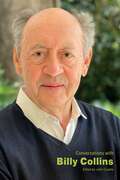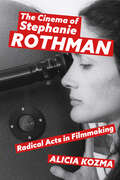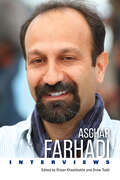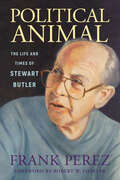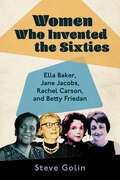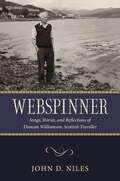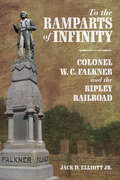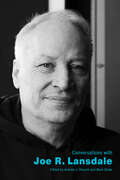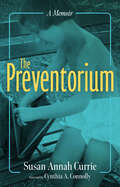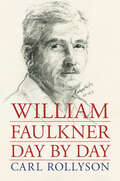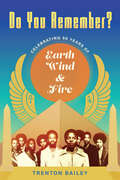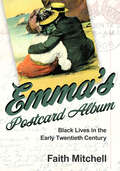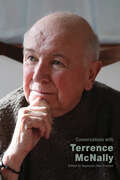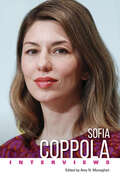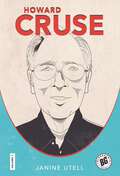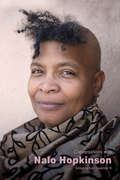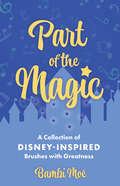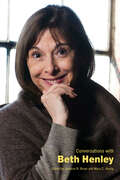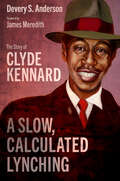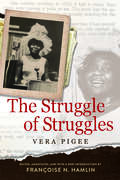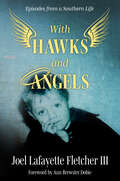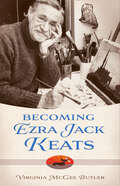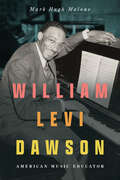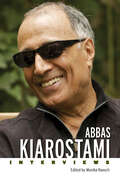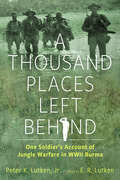- Table View
- List View
Conversations with Billy Collins (Literary Conversations Series)
by John CusatisBilly Collins “puts the ‘fun’ back in profundity,” says poet Alice Fulton. Known for what he has called “hospitable” poems, which deftly blend wit and erudition, Collins (b. 1941) is a poet of nearly unprecedented popularity. His work is also critically esteemed and well represented in The Norton Anthology of American Literature. An English professor for five decades, Collins was fifty-seven when his poetry began gathering considerable international attention. Conversations with Billy Collins chronicles the poet’s career beginning with his 1998 interview with Terry Gross on Fresh Air, which exponentially expanded his readership, three years prior to his being named United States Poet Laureate. Other interviewers range from George Plimpton, founder of the Paris Review, to Pulitzer Prize–winning poet Henry Taylor to a Presbyterian pastor, a physics professor, and a class of AP English Literature students. Over the course of the twenty-one interviews included in the volume, Collins discusses such topics as discovering his persona, that consistently affable voice that narrates his often wildly imaginative poems; why poetry is so loved by children but often met with anxiety by high school students; and his experience composing a poem to be recited during a joint session of Congress on the first anniversary of 9/11, a tragedy that occurred during his tenure as poet laureate. He also explores his love of jazz, his distaste for gratuitously difficult poetry and autobiographical poems, and his beguiling invention of a mock poetic form: the paradelle. Irreverent, incisive, and deeply life-affirming—like his twelve volumes of poetry—these interviews, gathered for the first time in one volume, will edify and entertain readers in the way his sold-out readings have done for the past quarter century.
The Cinema of Stephanie Rothman: Radical Acts in Filmmaking
by Alicia KozmaThe rare woman director working in second-wave exploitation, Stephanie Rothman (b. 1936) directed seven successful feature films, served as the vice president of an independent film company, and was the first woman to win the Directors Guild of America’s student filmmaking prize. Despite these career accomplishments, Rothman retired into relative obscurity. In The Cinema of Stephanie Rothman: Radical Acts in Filmmaking, author Alicia Kozma uses Rothman’s career as an in-depth case study, intertwining historical, archival, industrial, and filmic analysis to grapple with the past, present, and future of women’s filmmaking labor in Hollywood. Understanding second-wave exploitation filmmaking as a transitory space for the industrial development of contemporary Hollywood that also opened up opportunities for women practitioners, Kozma argues that understudied film production cycles provide untapped spaces for discovering women’s directorial work. The professional career and filmography of Rothman exemplify this claim. Rothman also serves as an apt example for connecting the structure of film histories to the persistent strictures of rhetorical language used to mark women filmmakers and their labor. Kozma traces these imbrications across historical archives. Adopting a diverse methodological approach, The Cinema of Stephanie Rothman shines a needed spotlight on the problems and successes of the memorialization of women’s directorial labor, connecting historical and contemporary patterns of gendered labor disparity in the film industry. This book is simultaneously the first in-depth scholarly consideration of Rothman, the debut of the most substantive archival materials collected on Rothman, and a feminist political intervention into the construction of film histories.
Asghar Farhadi: Interviews (Conversations with Filmmakers Series)
by Ehsan Khoshbakht and Drew ToddThe winner of two Academy Awards for Best Foreign Film in only five years, Asghar Farhadi (b. 1972) has become Iran’s most prominent director since the late Abbas Kiarostami. Around the world, especially in the international festival circuit, Farhadi is considered one of the great dramatist filmmakers of his generation. His reputation and influence in his home country is even greater, though also prone to misunderstandings, controversies, and divided critical reception.This volume offers a unique perspective into Farhadi's career in several key respects. Beginning with his work in television, the interviews collected here chart his rise from theater student to Iranian dramatist to celebrated international filmmaker. The majority of the interviews were conducted in Persian and have been translated into English for the first time.In the course of his career, Farhadi has become the new hope for Iran. On both nights of his Oscar wins, Iranians flooded the streets with joy in a rare (and illegal) celebration. Yet, like other contemporary Iranian filmmakers who have struggled to reconcile their national identity with their global repute as international filmmakers, Farhadi is at once feted and under fire by his own government. In addition to making recent films outside Iran, he has taken advantage of his celebrity status to make controversial statements on topics ranging from Donald Trump to poverty and capital punishment in Iran. He even asked Iran’s Judiciary to pardon Jafar Panahi, prompting the government to temporarily withdraw permission to shoot his renowned 2011 film A Separation. Asghar Farhadi: Interviews addresses the important dimensions that characterize contemporary Iranian filmmaking. Together, these interviews shed light on what Farhadi sees as his role and responsibilities as an Iranian filmmaker in a global age.
Political Animal: The Life and Times of Stewart Butler (Willie Morris Books in Memoir and Biography)
by Frank PerezDuring Mardi Gras 1973, Stewart Butler (1930–2020) fell in love with Alfred Doolittle—a wealthy socialite and schizophrenic from San Francisco. Their relationship was an improbable love story that changed the course of LGBTQ+ history. With Doolittle’s money, Butler was able to retire and devote his life to political activism in the cause of queer liberation. A survivor of the horrific Up Stairs Lounge arson, Butler was a founding member of the first statewide lesbian and gay rights organization in Louisiana and an early champion for transgender rights, playing a key role in the eight-year struggle to persuade PFLAG to become the first national LGBTQ+ organization to include trans people in its mission statement. In Political Animal: The Life and Times of Stewart Butler, author Frank Perez traces Butler’s amazing life from his early childhood in Depression-era New Orleans, his adolescence at Carville where his father worked, his first unsuccessful attempt at college, his time in the army as a closeted gay man, his adventures in Alaska, his transformation into a hippie in the 1960s, his love affair with Doolittle, his decades as a gay rights advocate, and ultimately, his twilight years as an elder statesman. Based on Butler's own personal papers, including hundreds of letters, and dozens of interviews, Political Animal paints an intimate portrait of a legendary figure in gay politics and the times in which he lived.
Women Who Invented the Sixties: Ella Baker, Jane Jacobs, Rachel Carson, and Betty Friedan
by Steve GolinWhile there were many protests in the 1950s—against racial segregation, economic inequality, urban renewal, McCarthyism, and the nuclear buildup—the movements that took off in the early 1960s were qualitatively different. They were sustained, not momentary; they were national, not just local; they changed public opinion, rather than being ignored. Women Who Invented the Sixties tells the story of how four women helped define the 1960s and made a lasting impression for decades to follow. In 1960, Ella Baker played the key role in the founding of the Student Nonviolent Coordinating Committee, which became an essential organization for students during the civil rights movement and the model for the antiwar and women’s movements. In 1961, Jane Jacobs published The Death and Life of Great American Cities, changing the shape of urban planning irrevocably. In 1962, Rachel Carson published Silent Spring, creating the modern environmental movement. And in 1963, Betty Friedan wrote The Feminine Mystique, which sparked second-wave feminism and created lasting changes for women. Their four separate interventions helped, together, to end the 1950s and invent the 1960s.Women Who Invented the Sixties situates each of these four women in the 1950s—Baker’s early activism with the NAACP and the Southern Christian Leadership Conference, Jacobs’s work with Architectural Forum and her growing involvement in neighborhood protest, Carson’s conservation efforts and publications, and Friedan’s work as a labor journalist and the discrimination she faced—before exploring their contributions to the 1960s and the movements they each helped shape.
Webspinner: Songs, Stories, and Reflections of Duncan Williamson, Scottish Traveller
by John D. NilesBorn in 1928 in a tent on the shore of Loch Fyne, Argyll, Duncan Williamson (d. 2007) eventually came to be recognized as one of the foremost storytellers in Scotland and the world. Webspinner: Songs, Stories, and Reflections of Duncan Williamson, Scottish Traveller is based on more than a hundred hours of tape-recorded interviews undertaken with him in the 1980s. Williamson tells of his birth and upbringing in the west of Scotland, his family background as one of Scotland’s seminomadic travelling people, his varied work experiences after setting out from home at about age fifteen, and the challenges he later faced while raising a family of his own, living on the road for half the year. The recordings on which the book is based were made by John D. Niles, who was then an associate professor at the University of California, Berkeley. Niles has transcribed selections from his field tapes with scrupulous accuracy, arranging them alongside commentary, photos, and other scholarly aids, making this priceless self-portrait of a brilliant storyteller available to the public. The result is a delight to read. It is also a mine of information concerning a vanished way of life and the place of singing and storytelling in Traveller culture. In chapters that feature many colorful anecdotes and that mirror the spontaneity of oral delivery, readers learn much about how Williamson and other members of his persecuted minority had the resourcefulness to make a living on the outskirts of society, owning very little in the way of material goods but sustained by a rich oral heritage.
To the Ramparts of Infinity: Colonel W. C. Falkner and the Ripley Railroad
by Jack D. Elliott Jr.Before William Faulkner, there was Colonel William C. Falkner (1825–1889), the great-grandfather of the prominent and well-known Mississippi writer. The first biography of Falkner was a dissertation by the late Donald Duclos, which was completed in 1961, and while Faulkner scholars have briefly touched on the life of the Colonel due to his influence on the writer’s work and life, there have been no new biographies dedicated to Falkner until now. To the Ramparts of Infinity: Colonel W. C. Falkner and the Ripley Railroad seeks to fill this gap in scholarship and Mississippi history by providing a biography of the Colonel, sketching out the cultural landscape of Ripley, Mississippi, and alluding to Falkner’s influence on his great-grandson’s Yoknapatawpha cycle of stories. While the primary thrust of the narrative is to provide a sound biography on Falkner, author Jack D. Elliott Jr. also seeks to identify sites in Ripley that were associated with the Colonel and his family. This is accomplished in part within the main narrative, but the sites are specifically focused on, summarized, and organized into an appendix entitled “A Field Guide to Colonel Falkner’s Ripley.” There, the sites are listed along with old and contemporary photographs of buildings. Maps of the area, plotting military action as well as the railroads, are also included, providing essential material for readers to understand the geographical background of the area in this period of Mississippi history.
Conversations with Joe R. Lansdale (Literary Conversations Series)
by Andrew J. Rausch and Mark SladeJoe R. Lansdale (b. 1951), the award-winning author of such novels as Cold in July (1989) and The Bottoms (2000), as well as the popular Hap and Leonard series, has been publishing novels since 1981. Lansdale has developed a tremendous cult audience willing to follow him into any genre he chooses to write in, including horror, western, crime, adventure, and fantasy. Within these genres, his stories, novels, and novellas explore friendship, race, and life in East Texas. His distinctive voice is often funny and always unique, as characterized by such works as Bubba Ho-Tep (1994), a novella that centers on Elvis Presley, his friend who believes himself to be John F. Kennedy, and a soul-sucking ancient mummy. This same novella won a Bram Stoker Award, one of the ten Bram Stoker Awards given to Lansdale thus far in his illustrious career. Wielding a talent that extends beyond the page to the screen, Landsdale has also written episodes for Batman: The Animated Series and Superman: The Animated Series. Conversations with Joe R. Lansdale brings together interviews from newspapers, magazines, and podcasts conducted throughout the prolific author’s career. The collection includes conversations between Lansdale and other noted peers like Robert McCammon and James Grady; two podcast transcripts that have never before appeared in print; and a brand-new interview, exclusive to the volume. In addition to shedding light on his body of literary work and process as a writer, this collection also shares Lansdale’s thoughts on comics, atheism, and martial arts.
The Preventorium: A Memoir (Cultures of Childhood)
by Susan Annah CurrieNamed the 2023 Best Memoir on Health/Adverse Childhood Experiences by Memoir MagazineOpened on February 17, 1929, the Mississippi State Preventorium operated continuously until 1976. The Mississippi Preventorium, like similar hospitals throughout the country, was an institution for sickly, anemic, and underweight children. It was established on the grounds of the Mississippi State Tuberculosis Sanitorium in the early years of the twentieth century when tuberculosis was a dreaded disease worldwide. The TB Sanitorium hospital housed those with tuberculosis, offering refuge for patients of all ages afflicted with the pernicious and contagious disease. Although located on the same medical campus, the preventorium was a separate medical institution for children; no children with TB were admitted in the sixty-year run of the hospital. The name preventorium meant a place of preventing disease as there was a fear of sickly children contracting TB. The Mississippi Preventorium was one of the last, if not the very last, of these special hospitals for children. Now closed, the preventorium housed over three thousand children, including author Susan Annah Currie. In this intimate memoir, Currie details her fifteen-month stay at the preventorium. From her arrival in May 1959 at six years old, Currie vividly explores the unique and isolating world that she and children across the country experienced. Her exacting routine, dictated by the nurses and doctors who now acted as her parents, erased the distinction between patients and created both a sense of community among the children and a deep sense of loneliness. From walking silently single file through the cold, narrow halls of the hospital to nurses recording every detail of their bathroom habits to extremely limited visitation from family, Currie’s time at the preventorium changed her and those around her, leaving an indelible mark even after their return home. While many of the records from the preventorium have been lost, Currie’s memoir opens to readers a lost history largely forgotten. Told in evocative prose, The Preventorium explores Currie’s personal trials, both in the hospital and in the echoes of her experiences into adulthood.
William Faulkner Day by Day
by Carl RollysonWilliam Faulkner has been the topic of numerous biographies, papers, and international attention. Yet there are no collected resources providing a comprehensive scope of Faulkner’s life and work before now. William Faulkner Day by Day provides unique insight into the daily life of one of America’s favorite writers. Beyond biography, this book is an effort to recover the diurnal Faulkner, to write in the present tense about past events as if they are happening now. More importantly, this book is concerned with more than the writer’s life. Instead, it examines the whole man—the daily, mundane, profound, life changing, and everything in between. Spanning from the 1825 birth of Faulkner’s great-grandfather to Faulkner’s death 137 years later to the day, author and biographer Carl Rollyson presents for the first time a complete portrait of Faulkner’s life untethered from any one biographical or critical narrative. Presented as a chronology of events without comment, this book is accompanied by an extensive list of principal personages and is supported by extensive archival research and interviews. Populated by the characters of Faulkner’s life—including family and friends both little known and internationally famous—this book is for Faulkner readers of all kinds with a wide variety of interests in the man and his work.
Do You Remember?: Celebrating Fifty Years of Earth, Wind & Fire (American Made Music Series)
by Trenton BaileyIn Do You Remember? Celebrating Fifty Years of Earth, Wind & Fire, Trenton Bailey traces the humble beginning of Maurice White, his development as a musician, and his formation of Earth, Wind & Fire, a band that became a global phenomenon during the 1970s. By the early 1980s, the music industry was changing, and White had grown weary after working constantly for more than a decade. He decided to put the band on hiatus for more than three years. The band made a comeback in 1987, but White’s health crisis soon forced them to tour without him. During the twenty-first century, the band has received numerous accolades and lifetime achievement and hall of fame awards. The band remains relevant today, collaborating with younger artists and maintaining their classic sound. Earth, Wind & Fire stood apart from other soul bands with their philosophical lyrics and extravagant visual art, much of which is studied in the book, including album covers, concerts, and music videos. The lyrics of hit songs are examined alongside an analysis of the band’s chart success. Earth, Wind & Fire has produced twenty-one studio albums and several compilation albums. Each album is analyzed for content and quality. Earth, Wind & Fire is also known for using ancient Egyptian symbols, and Bailey thoroughly details those symbols and Maurice White’s fascination with Egyptology. After enduring many personnel changes, Earth, Wind & Fire continues to perform around the world and captivate diverse audiences.
Emma's Postcard Album: Black Lives in the Early Twentieth Century (Atlantic Migrations and the African Diaspora)
by Faith MitchellBCALA 2023 Outstanding Contribution to Publishing Citation Award winnerThe turn of the twentieth century was an extraordinarily difficult period for African Americans, a time of unchecked lynchings, mob attacks, and rampant Jim Crow segregation. During these bleak years, Emma Crawford, a young African American woman living in Pennsylvania, corresponded by postcard with friends and family members and collected the cards she received from all over the country. Her album—spanning from 1906 to 1910 and analyzed in Emma's Postcard Album—becomes an entry point into a deeply textured understanding of the nuances and complexities of African American lives and the survival strategies that enabled people “to make a way from no way.” As snippets of lived experience, eye-catching visual images, and reflections of historical moments, the cards in the collection become sources for understanding not only African American life, but also broader American history and culture. In Emma's Postcard Album, Faith Mitchell innovatively places the contents of this postcard collection into specific historic and biographical contexts and provides a new interpretation of postcards as life writings, a much-neglected aspect of scholarship. Through these techniques, a riveting world that is far too little known is revealed, and new insights are gained into the perspectives and experience of African Americans. Capping off these contributions, the text is a visual feast, illustrated with arresting images from the Golden Age of postcards as well as newspaper clippings and other archival material.
Conversations with Terrence McNally (Literary Conversations Series)
by Raymond-Jean FrontainArriving in New York at the tail end of what has been termed the “Golden Age” of Broadway and the start of the Off-Broadway theater movement, Terrence McNally (1938–2020) first established himself as a dramatist of the absurd and a biting social critic. He quickly recognized, however, that one is more likely to change people’s minds by first changing their hearts, and—in outrageous farces like The Ritz and It’s Only a Play—began using humor more broadly to challenge social biases. By the mid-1980s, as the emerging AIDS pandemic called into question America’s treatment of persons isolated by suffering and sickness, he became the theater’s great poet of compassion, dramatizing the urgent need of human connection and the consequences when such connections do not take place. Conversations with Terrence McNally collects nineteen interviews with the celebrated playwright. In these interviews, one hears McNally reflect on theater as the most collaborative of the arts, the economic pressures that drive the theater industry, the unique values of music and dance, and the changes in American theater over McNally’s fifty-plus year career. The winner of four competitive Tony Awards as the author of the Best Play (Love! Valour! Compassion! and Master Class) and author of the book for the Best Musical (Kiss of the Spider Woman and Ragtime), McNally holds the distinction of being one of the few writers for the American theater who excelled in straight drama as well as musical comedy. In addition, his canon extends to opera; his collaboration with composer Jake Heggie, Dead Man Walking, has proven the most successful new American opera of the last twenty-five years.
Sofia Coppola: Interviews (Conversations with Filmmakers Series)
by Amy N. MonaghanSofia Coppola (b. 1971) was baptized on film. After appearing in The Godfather as an infant, it took twenty-five years for Coppola to take her place behind the camera, helming her own adaptation of Jeffrey Eugenides’s celebrated novel The Virgin Suicides. Following her debut, Coppola was the third woman ever to be nominated for Best Director and became an Academy Award winner for Best Original Screenplay for her sophomore feature, Lost in Translation. She has also been awarded the Golden Lion at the Venice Film Festival and Best Director at Cannes. In addition to her filmmaking, Coppola is recognized as an influential tastemaker. She sequenced the so-called Tokyo dream pop of the Lost in Translation soundtrack like an album, a success in its own right. Her third film, Marie Antoinette, further showcased Coppola’s ear for the unexpected needle drop, soundtracking the controversial queen’s life with a series of New Romantic bangers popular during the director’s adolescence. The conversations compiled within Sofia Coppola: Interviews mark the filmmaker’s progression from dismissed dilettante to acclaimed auteur of among the most visually arresting, melancholy, and wryly funny films of the twenty-first century. Coppola discusses her approach to collaboration, Bill Murray as muse, and how Purple Rain blew her twelve-year-old mind. There are interviews from major publications, but Coppola speaks with musician Kim Gordon for indie magazine Bust and Tavi Gevinson, then-adolescent founder of online teen magazine Rookie, as well. The volume also features a new and previously unpublished interview conducted with volume editor Amy N. Monaghan in which Coppola discusses her plans for the now-cancelled adaptation of The Custom of the Country. To read these interviews is to witness Sofia Coppola coming into her own as a world-renowned artist.
Howard Cruse (Biographix #1)
by Janine UtellHoward Cruse tells the life story of one of the most important figures in LGBTQ+ comics. A preacher’s kid from Alabama who became “the godfather of queer comics,” Cruse (1944–2019) was a groundbreaking underground cartoonist, a wicked satirist, an LGBTQ+ activist, and a mentor to a vast network of queer comics artists. His comic strip Wendel, published in The Advocate throughout the 1980s, is considered a revolutionary moment in the development of LGBTQ+ comics, as is his inaugurating the editorship of Gay Comix with Kitchen Sink Press in 1979, which furthered the careers of important artists like Jennifer Camper and Alison Bechdel. Cruse’s graphic novel Stuck Rubber Baby, published in 1995, fictionalizes his own coming out in the context of the civil rights movement in 1960s Birmingham and was a significant forerunner to contemporary graphic novels and memoirs. Howard Cruse draws on extensive archival research and interviews and covers Cruse’s entire body of work: the cute and zany Barefootz, the unexpected innovations of the Gay Comix stories, the domestic intimacies of Wendel, and the complexity and power of Stuck Rubber Baby. The book places Cruse’s art in the context of his life and his times, including the historic movements for gay rights and against the AIDS crisis, and it celebrates this extraordinary and essential figure of LGBTQ+ comics and American comics art more broadly.
Conversations with Nalo Hopkinson (Literary Conversations Series)
by Isiah Lavender IIIA key figure in contemporary speculative fiction, Jamaican-born Canadian Nalo Hopkinson (b. 1960) is the first Black queer woman as well as the youngest person to be named a Grand Master by the Science Fiction and Fantasy Writers of America. Her Caribbean-inspired narratives—Brown Girl in the Ring, Midnight Robber, The Salt Roads, The New Moon’s Arms, The Chaos, and Sister Mine—project complex futures and complex identities for people of color in terms of race, sex, and gender. Hopkinson has always had a vested interest in expanding racial and ethnic diversity in all facets of speculative fiction from its writers to its readers, and this desire is reflected in her award-winning anthologies. Her work best represents the current and ongoing colored wave of science fiction in the twenty-first century.In twenty-one interviews ranging from 1999 until 2021, Conversations with Nalo Hopkinson reveals a writer of fierce intelligence and humor in love with ideas and concerned with issues of identity. She provides powerful insights on code-switching, race, Afrofuturism, queer identities, sexuality, Caribbean folklore, and postcolonial science fictions, among other things. As a result, the conversations presented here very much demonstrate the uniqueness of her mind and her influence as a writer.
Part of the Magic: A Collection of Disney-Inspired Brushes with Greatness
by Bambi MoéPart of the Magic: A Collection of Disney-Inspired Brushes with Greatness is a book of remarkable and wildly entertaining anecdotal stories told through the lens of an entertainment industry insider. Author Bambi Moé enjoyed a twenty-year career at The Walt Disney Company in charge of all aspects of music for Walt Disney Television Animation. Her name, vocation, and background gave her exceptional access to pop culture and entertainment giants. The book takes readers on a nonstop ride and keeps them riveted throughout extremely candid encounters shared here for the first time. Moé’s fascinating true stories provide a rare insight into the creative process associated with music in animation and give readers a historical reference to The Walt Disney Company’s burgeoning direct-to-video empire. Her career exemplifies the rewards often associated with hard work, perseverance, integrity, and the ability to recognize potential in others. Often the only woman in a male-dominated work environment, Moé’s success will inspire young readers interested in pursuing a career in entertainment. Part of the Magic invites readers to consider their own stories and recognize their own universality. Like a photo that captures life’s moments and teaches us lessons, each of Moé’s brushes with greatness serves as a reminder that we are all connected by reason of our own humanity. Her joy extends far beyond the original encounter and multiplies in the retelling of these stories.
Conversations with Beth Henley (Literary Conversations Series)
by Jackson R. Bryer and Mary C. HartigWith roots in the American South, Beth Henley (b. 1952) has for four decades been a working playwright and screenwriter. Winner of the Pulitzer Prize in 1981 at the age of twenty-eight, Henley so far has written twenty-five produced plays that are always original, usually darkly comic, and often experimental. In these interviews, Henley speaks of the plays, from her early crowd-pleasers, Crimes of the Heart and The Miss Firecracker Contest, to her more experimental plays, including The Debutante Ball and Control Freaks, to her brilliant and time-bending play, The Jacksonian. Henley is a master at writing about the duality of human experience—the beautiful and the grotesque, the cruel and the loving. This duality provokes in Henley both amazement and compassion. She discusses here not only her admiration for Chekhov and other influences, but also her process of bringing a play from notebooks of images and bits of dialogues through rumination, writing, and rewriting to rehearsals and previews. The interviews range from 1981, just before she won the Pulitzer Prize, to 2020 and cover nearly forty years of a creative life, which, as Henley remarks in the most recent interview, is “such a life worth living: to be in tune with the creative process.”
A Slow, Calculated Lynching: The Story of Clyde Kennard (Race, Rhetoric, and Media Series)
by Devery S. AndersonIn the years following Brown v. Board of Education, countless Black citizens endured violent resistance and even death while fighting for their constitutional rights. One of those citizens, Clyde Kennard (1927–1963), a Korean War veteran and civil rights leader from Hattiesburg, Mississippi, attempted repeatedly to enroll at the all-white Mississippi Southern College—now the University of Southern Mississippi—in the late 1950s. In A Slow, Calculated Lynching: The Story of Clyde Kennard, Devery S. Anderson tells the story of a man who paid the ultimate price for trying to attend a white college during Jim Crow. Rather than facing conventional vigilantes, he stood opposed to the governor, the Mississippi State Sovereignty Commission, and other high-ranking entities willing to stop at nothing to deny his dreams. In this comprehensive and extensively researched biography, Anderson examines the relentless subterfuge against Kennard, including the cruelly successful attempts to frame him—once for a misdemeanor and then for a felony. This second conviction resulted in a sentence of seven years hard labor at Mississippi State Penitentiary, forever disqualifying him from attending a state-sponsored school. While imprisoned, he developed cancer, was denied care, then sadly died six months after the governor commuted his sentence. In this prolonged lynching, Clyde Kennard was robbed of his ambitions and ultimately his life, but his final days and legacy reject the notion that he was powerless.Anderson highlights the resolve of friends and fellow activists to posthumously restore his name. Those who fought against him, and later for him, link a story of betrayal and redemption, chronicling the worst and best in southern race relations. The redemption was not only a symbolic one for Kennard but proved healing for the entire state. He was gone, but countless others still benefit from Kennard’s legacy and the biracial, bipartisan effort he inspired.
The Struggle of Struggles (Civil Rights in Mississippi Series)
by Vera PigeeNamed one of five best books on women in the Civil Rights Movement by Wall Street JournalFrom 1955 to 1975, Vera Pigee (1924–2007) put her life and livelihood on the line with grassroots efforts for social change in Mississippi, principally through her years of leadership in Coahoma County’s NAACP. Known as the “Lady of Hats,” coined by NAACP executive secretary Roy Wilkins, Pigee was a businesswoman, mother, and leader. Her book, The Struggle of Struggles, offers a detailed view of the daily grind of organizing for years to open the state’s closed society. Fearless, forthright, and fashionable, Pigee also suffered for her efforts at the hands of white supremacists and those unwilling to accept strong women in leadership. She wrote herself into the histories, confronted misinformation, and self-published one of the first autobiographies from the era. Women like her worked, often without accolade or recognition, in their communities all over the country, but did not document their efforts in this way.The Struggle of Struggles, originally published in 1975, spotlights the gendered and generational tensions within the civil rights movement. It outlines the complexity, frustrations, and snubs, as well as the joy and triumphs that Pigee experienced and witnessed in the quest for a fairer and more equitable nation. This new edition begins with a detailed introductory essay by historian Françoise N. Hamlin, who interviewed Pigee and her daughter in the few years preceding their passing, as well as their coworkers and current activists. In addition to the insightful Introduction, Hamlin has also provided annotations to the original text for clarity and explanation, along with a timeline to guide a new generation of readers.
With Hawks and Angels: Episodes from a Southern Life (Willie Morris Books in Memoir and Biography)
by Joel Lafayette Fletcher IIIWith Hawks and Angels: Episodes from a Southern Life chronicles the fortunate life of a man born in the Cajun country of Louisiana and his interaction with the three distinct parts of his home state: the swampy, laissez-faire South where he was born, the red clay hills and piney woods of northern Louisiana where his relatives lived, and exotic New Orleans, where he was educated. Author Joel Lafayette Fletcher III examines his childhood on the campus of what is now the University of Louisiana at Lafayette where his father, Joel Lafayette Fletcher Jr., was president for twenty-five years, to his time as a student at Tulane. The book follows Fletcher through his service as a naval officer—when he began to admit to himself, accept, and explore who he really was—to his life in Europe and, eventually, Virginia where he now resides. With Hawks and Angels intimately explores the life of a young man growing up in the racially segregated Deep South while coming to terms with being gay at a time when being out was not socially acceptable. Based on his personal journals and recollections and filled with the unique characters he met along the way, With Hawks and Angels is the culmination of writing that, for Fletcher, was a way of holding onto an important part of his true self that for many years he felt compelled to hide.
Becoming Ezra Jack Keats (Willie Morris Books in Memoir and Biography)
by Virginia McGee ButlerBecoming Ezra Jack Keats offers the first complete biography of acclaimed children’s author and illustrator Ezra Jack Keats (1916–1983) intended for adult readers. Drawing extensively from his unpublished autobiography and letters, Becoming Ezra Jack Keats covers the breadth of Keats’s life, taking readers through his early years as the child of immigrant parents, his introduction to illustration and writing, and the full arc of his remarkable career.Beyond a standard biography, this volume presents a time capsule of the political, social, and economic issues evolving during the span of Keats’s lifetime. It also addresses his trailblazing commitment to representation and diversity, most notably in his work The Snowy Day, which won the Caldecott Medal as the first full-color picture book to feature a Black child as the protagonist. Keats far surpassed his father’s prediction that he would be a starving artist. Instead, as shown in Becoming Ezra Jack Keats, he is now regarded as one of the most influential figures in children’s literature, having published twenty-two books translated into sixteen languages, all featuring the diversity he saw in the children outside the window of his Brooklyn studio.
William Levi Dawson: American Music Educator (American Made Music Series)
by Mark Hugh MaloneWilliam Levi Dawson (1899–1990) overcame adversity and Jim Crow racism to become a nationally recognized composer, choral arranger, conductor, and professor of music. In William Levi Dawson: American Music Educator, Mark Hugh Malone tells the fascinating tale of Dawson’s early life, quest for education, rise to success at the Tuskegee Institute, achievement of national notoriety as a composer, and retirement years spent conducting choirs throughout the US and world.From his days as a student at Tuskegee in the final years of Booker T. Washington’s presidency, Dawson continually pursued education in music, despite racial barriers to college admission. Returning to Tuskegee later in life, he became director of the School of Music. Under his direction, the Tuskegee Choir achieved national recognition by singing at Radio City Music Hall, presenting concerts for Presidents Herbert Hoover and Franklin D. Roosevelt, and performing on nationwide radio and television broadcasts.Dawson’s Negro Folk Symphony, only the second extended musical work to be written by an African American, was premiered by Leopold Stokowski and the Philadelphia Orchestra in both Philadelphia and New York City. Dawson’s arrangements of spirituals, the original folk music of African Americans enslaved in America during the antebellum period, quickly became highly sought-after choral works. This biographical account of Dawson's life is narrated with a generous sprinkling of his personal memories and photographs.
Abbas Kiarostami: Interviews (Conversations with Filmmakers Series)
by Monika RaeschThe cinephile community knows Abbas Kiarostami (1940–2016) as one of the most important filmmakers of the previous decades. This volume illustrates why the Iranian filmmaker achieved critical acclaim around the globe and details his many contributions to the art of filmmaking. Kiarostami began his illustrious career in his native Iran in the 1970s, although European and American audiences did not begin to take notice until he released his 1987 feature Where’s the Friend’s House? His films defy established conventions, placing audiences as active viewers who must make decisions about actions and characters while watching the narratives unfold. He asks viewers to question the genre construct (Close-Up) and challenges them to determine how to watch and imagine a narrative (Ten and Shirin). In recognition for his approach to the craft, Kiarostami was awarded many honors during his lifetime, including the top prize at the Cannes Film Festival in 1997 for Taste of Cherry. In Abbas Kiarostami: Interviews, editor Monika Raesch collects eighteen interviews (several translated into English for the first time), lectures, and other materials that span Kiarostami’s career in the film industry. In addition to exploring his expertise, the texts provide insight into his life philosophy. This volume offers a well-rounded picture of the filmmaker through his conversations with journalists, film scholars, critics, students, and audience members.
A Thousand Places Left Behind: One Soldier’s Account of Jungle Warfare in WWII Burma
by Peter K. Lutken Jr.Born and raised in Mississippi, Peter K. Lutken, Jr. (1920–2014) joined the army in 1941 and was assigned to the Coast Artillery. Originally sent to India to guard airfields, he was reassigned to the British V Force, then the American OSS (Office of Strategic Services and precursor to the CIA) after he volunteered for reconnaissance missions behind Japanese lines. Skills he had learned as a boy in the backwoods and swamps around the Pearl River stood him in good stead, and by the end of the war, he attained the rank of major, commanding an entire battalion of ethnic Kachins and other local people of northern Burma (now called Myanmar). Lutken's stories carry the reader along as he sails on a troop ship to India, then treks into the mountainous jungles of northern Burma to gather intelligence and engage in guerrilla warfare with the Japanese. In his straightforward way, he describes how he learned the language of the Kachins and much about their customs and legends, and how he fought alongside them for the course of the war. Adventures of rafting uncharted rivers, surprise attacks, sabotage, natural hazards and disease, feasts and ceremonies, the plight of refugees, and tragic events of war are all told from the perspective of a young soldier, who finds himself half a world away from home. Based on hundreds of pages of transcripts from tapes recorded late in his life, A Thousand Places Left Behind recounts the untold story not just of one soldier’s experiences, but of the little-known history of American and British forces in Burma during World War II. Supported by original maps based on Lutken’s personal travels as well as photographs from his scrapbook, the book traces Lutken’s journey overseas, his expeditions into the jungle, and his return to Jackson, Mississippi in 1945. Beyond the war, Lutken’s connection with the Kachins culminated in “Project Old Soldier,” a crop exchange program which he and other veterans of OSS Detachment 101 initiated in the 1990s and which lasted until after his death in 2014. The book tells a remarkable story of bravery, friendship, history, and the unbreakable bonds forged in times of war.
